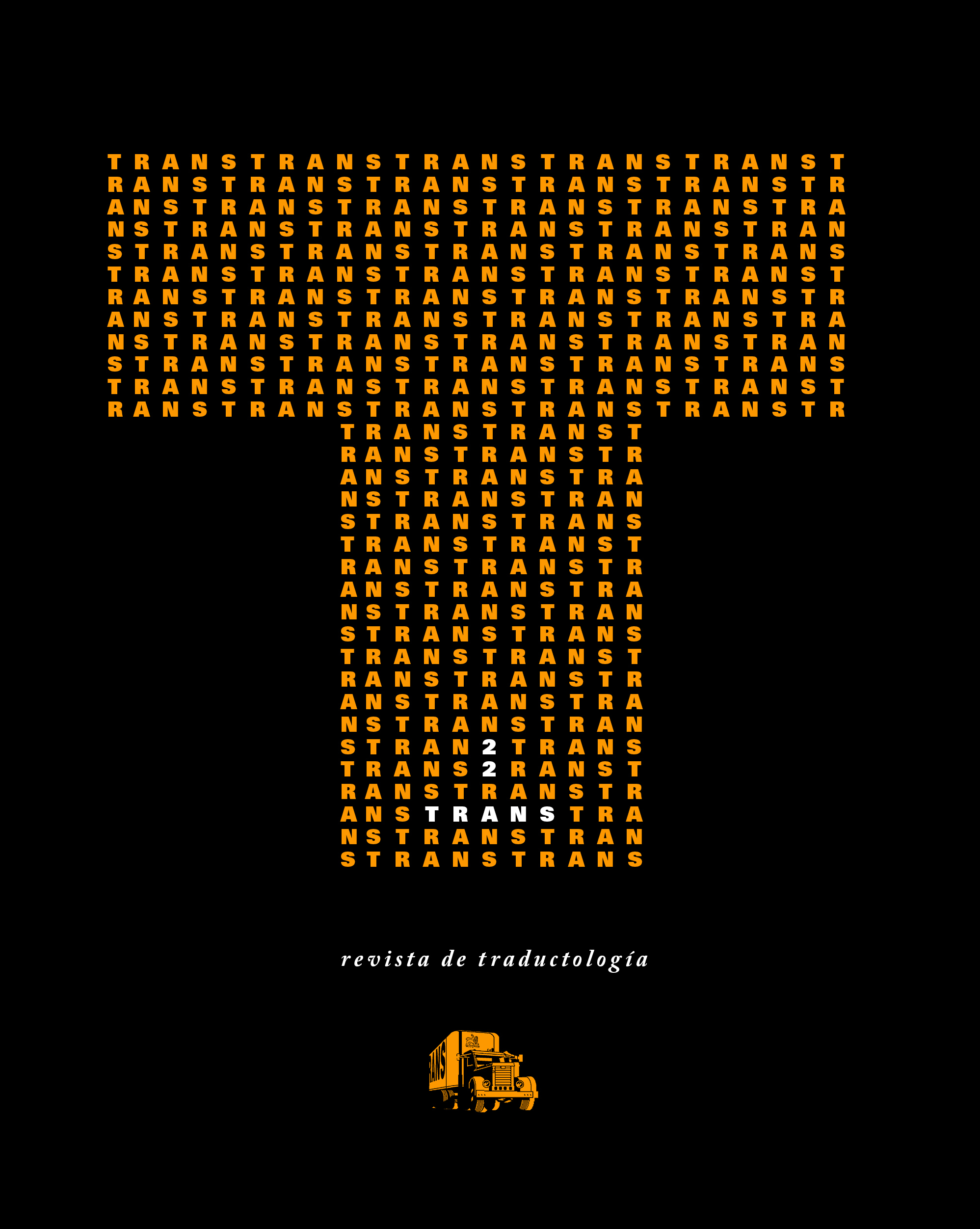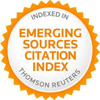The translation of the speech of the Indian characters in E. M. Forster’s A Passage to India
DOI:
https://doi.org/10.24310/TRANS.2018.v0i22.3123Keywords:
Literary translation, E. M. Forster, English, Spanish, dialogues, IndiaAbstract
The last novel published by British author E. M. Forster during his lifetime, A Passage to India, takes place in colonial India at the beginning of the 20th century. There are three different translations into Spanish of this novel, and in this paper we will analyse how these translations render the speech of the Indian characters.Downloads
Metrics
Publication Facts
Reviewer profiles N/A
Author statements
Indexed in
-
—
- Academic society
- N/A
- Publisher
- Universidad de Málaga
References
ALLEN, Glen O. (1955): «Structure, Symbol, and Theme in E. M. Forster's A Passage to India», PMLA, 70/5, 934-954.
ASOCIACIÓN DE ACADEMIAS DE LA LENGUA ESPAÑOLA (2010): Nueva gramática de la lengua española, Madrid: Espasa.
BANSAL, R. K y HARRISON, J. B. (1998) [1972]: Spoken English, Hyderabad: Orient Longman.
BEER, John (1987): «Conclusion: A Passage to India and the Versatility of the Novel», en John BEER (ed.), A Passage to India: Essays in interpretation, Basingstoke: Macmillan, 132-152.
BRADBURY, Malcom (1979): «Introduction». En: Malcom Bradbury (ed.), A Passage to India: A selection of critical essays. Londres: McMillan, 11-27.
BURRA, Peter (1983) [1957]: «Introduction to the Everyman edition», en E. M. FORSTER, A Passage to India, Harmondsworth: Penguin, 319-333.
CHAUDHURI, Nirad C. (1954): «Passage to and from India», Encounter, 2, 19-24.
CHILDS, Peter (2007): «A Passage to India», en David BRADSHAW (ed.), The Cambridge Companion to E. M. Forster, Cambridge: Cambridge University Press, 188-208.
DAVYDOVA, Julia (2011): The Present Perfect in non-Native Englishes: A Corpus-Based Study of Variation, Berlín, Nueva York: De Gruyter Mounton.
DAS, Bikram K. (1989) [1975]: «A Stylistic Analysis of the Speech of the Indian Characters in Forster's A Passage to India», en Vasant A. SHAHANE (ed.), Focus on Forster's “A Passage to India”. Indian essays in criticism, Hyderabad: Orient Longman, 78-88.
DOBROGOSZCZ, Tomasz (2010): «A Passage to OU-BOUM: Homi Bhabha reads E. M. Forster», en Krzysztof FORDONSKI (ed.), Vasorvia: Instytut Kulturologii i Lingwistyki Antropocentrycznej, Uniwersytetu Warszawskiego and International E. M. Forster Society, 69-89.
FERNÁNDEZ, Francisco (1988): «A Passage to India: el lenguaje artístico y simbólico de E. M. Forster», Revista alicantina de estudios ingleses, 1, 33-79.
FORSTER, Edward Morgan (1953): The Hill of Devi. Nueva York: Harcourt, Brace and Co.
FORSTER, Edward Morgan (1955): El paso a la India, trad. Juan Rodolfo Wilcock, Buenos Aires: Sur.
FORSTER, Edward Morgan (1981): Un viaje a la India, trad. José Luis López Muñoz, Madrid: Alianza.
FORSTER, Edward Morgan (1989) [1957]: «Prefatory Note to the Everyman edition», en E. M. FORSTER, A Passage to India, Harmondsworth: Penguin, 317-318.
FORSTER, Edward Morgan (2004): Pasaje a la India, trad. Juan Gabriel Vásquez, Barcelona: Folio.
FORSTER, Edward Morgan (2015) [1924]: A Passage to India, Londres: Penguin.
FURBANK, P. N. (1979): E. M. Forster: A life, Oxford: Oxford University Press.
GUMPERZ, John J.; AULAKH, Gurinder y KALTMAN, Hannah (1982): «Thematic structure and progression in discourse», en John J. GUMPERZ, Language and Social Identity, Cambridge: Cambridge University Press, 22-56.
«Jolly well» (2018): Merriam-Webster, <https://www.merriam-webster.com/dictionary/jolly%20well> [consulta: 26-IX-2018].
KORTMANN, Bernd y LUNKENHEIMER, Kerstin (eds.) (2013): The Electronic World Atlas of Varieties of English. Leipzig: Max Planck Institute for Evolutionary Anthropology, <http://ewave-atlas.org> [consulta: 26-IX-2018].
LIN, Lidan (1997): «The irony of colonial humanism: A Passage to India and the politics of the posthumanism», ARIEL: A Review of International English Literature, 38 /4, 133-153.
LOSADA DURÁN, José Ramón (1989): «Nationalism and Imperialism in E. M. Forster's A Passage to India», Anglo-American Studies, 9/2, 153-15.
MALIK, Charu (1997): «To express the subject of friendship: Masculine desire and colonialism in A Passage to India», en Robert K. MARTIN y George PIGGFORD (eds.), Queer Forster, Chicago: University of Chicago Press, 221-236.
MARTÍNEZ-CABEZA LOMBARDO, Miguel Ángel (1994): «Conversations between British and Indian characters in A Passage to India: a reappraisal of politeness theory», Revista Canaria de Estudios Ingleses, 29, 197-206.
MOREY, Peter (2007): «Postcolonial Forster», en David BRADSHAW (ed.), The Cambridge Companion to E. M. Forster, Cambridge: Cambridge University Press, 254-273.
MOURA, Jean Marc (1996): «Le renversement du réalisme colonial dans A Passage to India d'E. M. Forster», Études anglaises, 49/3, 283-294.
MUKHERJEE, Meenakshi (1989) [1975]:: «On Teaching A Passage to India», en Vasant A. SHAHANE (ed.), Focus on Forster's “A Passage to India”. Indian essays in criticism, Hyderabad: Orient Longman, 98-104.
PARRY, Benita (1978): «The politics of representation in A Passage to India», en John BEER (ed.), A Passage to India: Essays in interpretation, Basingstoke: Macmillan, 27-43.
S. A. (1997): «Review, Springfield Sunday Republican», en Philip GARDNER (ed.), The Critical Heritage Series: E.M. Forster, Londres: Routledge, 281-283.
SAID, Edward W. (1978): Orientalism, Londres: Routledge and Paul Kegan.
SHAHANE, Vasant A. (ed.) (1989) [1975]: «Itinerary of Forster's visits to India», en Vasant A. SHAHANE (ed.), Focus on Forster's “A Passage to India”. Indian essays in criticism, Hyderabad: Orient Longman, vii-xii.
SIVARAMAKRISHNA, M. (1989) [1975]: «Marabar Caves Revisited», en Vasant A. SHAHANE (ed.), Focus on Forster's “A Passage to India”. Indian essays in criticism, Hyderabad: Orient Longman, 5-17.
STALLYBRASS, Oliver (1989): «Editor's introduction», en E. M. FORSTER, A Passage to India, Harmondsworth: Penguin, 7-28.
V. V. A. A. (1989). «Notes», en E. M. FORSTER, A Passage to India, Harmondsworth: Penguin, 337-359.
VALDEÓN, Roberto Antonio (1994-1995): «Funciones sociales del inglés en A Passage to India», Archivum: Revista de la Facultad de Filología, 44-45/2, 149-172.
Downloads
Published
How to Cite
Issue
Section
License
All contents published in TRANS. Revista de Traductología are protected under the Creative Commons Attribution-NonCommercial-ShareAlike 4.0 International (CC BY-NC-SA 4.0) license. All about this license is available in the following link: <http://creativecommons.org/licenses/by-nc-sa/4.0>
Users can copy, use, redistribute, share and exhibit publicly as long as:
- The original source and authorship of the material are cited (Journal, Publisher and URL of the work).
- It is not used for comercial purposes.
- The existence of the license and its especifications are mentioned.
- ShareAlike — If you remix, transform, or build upon the material, you must distribute your contributions under the same license as the original.
There are two sets of authors’ rights: moral and property rights. Moral rights are perpetual prerogatives, unrenounceable, not-transferable, unalienable, imprescriptible and inembargable. According to authors’ rights legislation, TRANS. Revista de Traductología recognizes and respects authors moral rights, as well as the ownership of property rights, which will be transferred to University of Malaga in open access.
The property rights are referred to the benefits that are gained by the use or the dissemination of works. TRANS. Revista de Traductología is published in an open access form and it is exclusively licenced by any means for doing or authorising distribution, dissemination, reproduction, , adaptation, translation or arrangement of works.
Authors are responsable for obtaining the necessary permission to use copyrighted images.













21.png)
